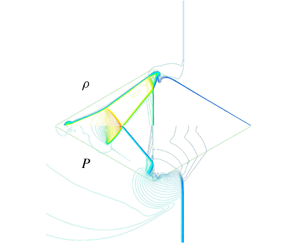Article contents
Shock wave interaction with a polygonal bubble containing two different gases, a numerical investigation
Published online by Cambridge University Press: 26 February 2020
Abstract

The interaction between a planar shock wave propagating in air and a polygonal bubble (composed of two triangles) containing two different gases is studied numerically. Studying the interaction between an oncoming shock wave with front- and rear-facing triangles containing light and heavy gases is of great importance in understanding the complex shock wave propagation, interaction and hydrodynamic instabilities as well as their effect on mitigating or enhancing the colliding shock/blast wave. Two different cases were studied: in the first case, the front triangle contained sulfur hexafluoride (SF6) and the rear one contained helium (He); while in the second case, He is in the front and SF6 in the rear triangle. As the speed of sound in He is significantly higher than that in SF6 and in air, different flow fields were evolved. When SF6 is placed in the front triangle, the shock wave transmitted through the SF6 is reflected back from the interface separating the two gases and starts propagating downstream; over the He segment of the bubble, the incident shock wave (in the open air) is already seen over the He section and it submits compression waves into the He gas. These compression waves travel upstream and downstream; in their upstream movement they generate compression waves into the ambient air ahead of the incident shock wave. The part moving downstream will hit the interface separating SF6 and He, resulting in a complex wave pattern. A completely different wave pattern is visible when He is placed in the front triangle. Now the fastest shock is the transmitted shock wave in the He section; it reaches the membrane separating the two gases well before the incident shock wave reaches this location. Unlike the previous case, now the resulting flow in the rear triangle of the bubble is affected not only by the incident shock wave but also by the transmitted compression waves from the helium section. Furthermore, when helium is placed in the front section of the bubble, the compression waves in the He impacts the rear triangle of the bubble (containing SF6) almost like a planar shock wave. This is different from the previous case where SF6 was in the front section; then the shock wave impacting on the rear bubble containing He had a completely different shape due to its propagation into the SF6 bubble. This resulted in completely different peak pressures.
JFM classification
- Type
- JFM Papers
- Information
- Copyright
- © The Author(s), 2020. Published by Cambridge University Press
References
- 16
- Cited by




